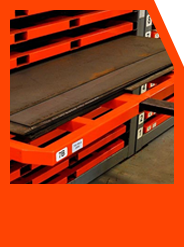OSHA requirements play an important role in keeping workers safe, but the rules are always evolving and often nuanced, which can make them difficult to follow consistently over time.
If your racking system or anything else in your facility is not compliant, you’re putting your employees and your business at risk of injury or fine. OSHA standards are meant to ensure your team is safe, with several aspects that apply directly to racking systems. If you’re convinced your homemade racking is good to go, you might be in for a surprise down the road – and by then it might be too late.
Here are some racking-specific OSHA standards to be aware of and some steps you can take to help ensure your system is safe and compliant.
Key Areas of OSHA Racking: Support, Load Rating, and Maintenance
Most racking issues are covered under the General Duty clause of OSHA, which regulates installation and maintenance guidelines to preserve worker safety.
Three common racking issues are cited under the General Duty clause:
- Rack columns with insufficient support: Rack columns must be supported with column base plates and must be anchored to the floor with durable anchor bolts capable of resisting the load put on the rack.
- Racks without load ratings: Employers are required to mention the minimum and maximum permissible load for every rack, in addition to the maximum uniform load distribution per level, or the maximum total load at each bay.
- Improper rack maintenance: Failure to properly maintain your racking system can lead to an unsafe environment, not to mention costly damage to your racks. OSHA requires employers to develop a maintenance program to work against this. Your maintenance program should clearly define the clearance, alignment, level, and plumb in accordance with the rack manufacturer’s instructions.
Implementing Your Own Rack Inspection Plan
The best way to ensure the continued compliance and safety of your racking system is to implement a program of regularly scheduled inspections – all of which should be performed by a qualified professional with a detailed understanding of your system. This gives you the chance to check your racks for any damage or abuse, document your findings, and execute a plan to correct them.
The Rack Manufacturers Institute recommends checking for four specific conditions:
- Are your racks plumb and straight? The maximum top-to-bottom out-of-plumb ratio of a loaded rack is the total rack height/240 inches. This is measured from the centerline of the column upright at the floor to the centerline of the column upright at the top of the shelf elevation.
- Does the rack show visible rust or corrosion? Any rust or corrosion can be a sign of weakening metal. If the rack’s paint is scraped, it may have suffered a collision and should be checked for plumbness and straightness of the upright columns.
- Is load capacity clearly shown? Your rack manufacturer should publish frame capacity charts, and any applicable information should be prominently displayed on a placard at the end of each aisle. Make sure you never change a rack’s original configuration or weight load without engineer approval. If an approved modification is made, remember to update the placards to reflect the new specs. Be wary of overloading, which can lead to beam deflection.
- Is the rack damaged? Damage is the most common and serious issue that can affect the integrity of a pallet racking system. Be sure to check your rack’s beams, upright columns, and foot plate/anchors as part of your regular inspections.
Stay Safe and Compliant with Big Steel Rack
Big Steel Rack is the most innovative high-density storage solution for organizing and storing your sheet metal safely and efficiently. Our sheet metal storage racks and metal tubing and bar stock racks are made in the U.S. to help OEMs, job shops, sheet metal fabricators, and manufacturing companies in general increase floor space, streamline organization, and improve safety – so you can spend more time focusing on production and less time searching for the product you need.
All Big Steel Rack systems are load-rated and clearly labeled with maximum load capacities for both racks and pallets to help keep your warehouse compliant and your workers safe. Contact us today to get started building the perfect storage solution for your business.
Have questions or comments about your racking system’s OSHA compliance? Drop us a line below to let us know what you think!















Add a Comment